Archilife Investingating Mission for SB05Tokyo (5)Date: 2005-09-26
Section: SB Series of International Conferences | 
為了積極在國際間發聲與發揮影響力,在江哲銘評審委員與張桂鳳小姐的努力奔走下,於9月26日上午10點30分左右促成黃晉英秘書長與iiSBE秘書長Nils Larrson先生夫婦與理事Ronald Rovers先生的會晤,針對祐生參與iiSBE的角色與方式進行初步的溝通與討論,席間,黃晉英秘書長也詳盡解說共生化理念與作法和對方交換意見與想法。為了讓祐生更深入了解iiSBE的運作與現況,Nils Larrson先生與Ronald Rovers先生也邀請黃晉英秘書長參加當日下午即將召開的一年一度理事會議,以認識來自其他國家的理事代表。在iiSBE理事會議中,黃晉英秘書長不放過任何一隻可以交流的手,為的是要充分利用每一個機會,讓祐生站上國際舞台。
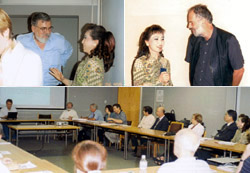 To speak to the world and to exert our influence, a meeting between Secretary General Huang Chin-ying and Mr. and Mrs. Nils Larrson, iiSBE Secretary General, and Mr. Ronald Rovers, iiSBE Chairperson, was finally arranged at about 10:30 am, September 26 with the efforts of Mr. Chiang Che-ming and Miss Chang Kuei-feng to discuss the role and manner of the foundation's participation in the iiSBE. At the meeting, Secretary General Huang Chin-ying explained in detail the concept and practice of symbiosis and exchanged opinions and ideas with the iiSBE. To let the foundation understand more about the operation and current status of the iiSBE, Larrson and Rovers invited Secretary General Huang Chin-ying to join the annual board meeting of the iiSBE in the following afternoon in order to make acquaintance with representatives from other countries. At the iiSBE board meeting, Secretary General Huang Chin-ying never wasted any chance to exchange with any directors of the iiSBE in order to make full use of every chance to let Archilife Research Foundation stand on the international stage. To speak to the world and to exert our influence, a meeting between Secretary General Huang Chin-ying and Mr. and Mrs. Nils Larrson, iiSBE Secretary General, and Mr. Ronald Rovers, iiSBE Chairperson, was finally arranged at about 10:30 am, September 26 with the efforts of Mr. Chiang Che-ming and Miss Chang Kuei-feng to discuss the role and manner of the foundation's participation in the iiSBE. At the meeting, Secretary General Huang Chin-ying explained in detail the concept and practice of symbiosis and exchanged opinions and ideas with the iiSBE. To let the foundation understand more about the operation and current status of the iiSBE, Larrson and Rovers invited Secretary General Huang Chin-ying to join the annual board meeting of the iiSBE in the following afternoon in order to make acquaintance with representatives from other countries. At the iiSBE board meeting, Secretary General Huang Chin-ying never wasted any chance to exchange with any directors of the iiSBE in order to make full use of every chance to let Archilife Research Foundation stand on the international stage.
此外,為了讓祐生主導之熱帶及亞熱帶地區永續建築之微氣候設計的研討會於9月27日的Special Session有最完美的成果展示,李君如小姐與李彥頤先生不惜犧牲參觀橫濱的行程,留在飯店編製簡報。
Furthermore, to ensure the perfect results of the workshop 2 : Bio-Climatic Design of SB in Tropical & Subtropical Region held at the Special Session on September 27, Miss Li Chun-ju and Mr. Li Yen-yi gave up their trip to Yokohama to prepare the presentation at the hotel.
在此同時,其餘團員則參加SB05Tokyo大會安排之參觀行程,前往橫濱參觀大棧橋國際客輪碼頭旅客活動中心、橫濱中華街、紅磚屋倉庫及山下公園等。
At the same time, other members joined the Yokohama tour arranged by the organizers of SB05Tokyo to visit the Yokohama International Passenger Terminal, Yokohama Chinatown, Yokohama Red Brick Warehouse, and Yamashita Park.
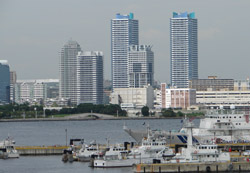 經過一小時車程後,團員們到達第一站:大棧橋國際客輪碼頭旅客活動中心(Yokohama International Passenger Terminal),大棧橋國際客輪碼頭被稱為「美利堅碼頭」,是橫濱港的門戶。世界級豪華客輪伊利莎白女王號等皆在此停泊,是一個國際性的客輪碼頭。旅客活動中心造型為一鋼筋混凝土造郵輪船型建築,屋外走道及休息座椅係取材位於熱帶雨林的巴西所出產之檀木構築而成,屋頂上為用巴西檀木鋪陳的走道及鋪植草皮綠地的屋頂花園。室內同以巴西檀木做為主要裝修材料,並搭配大片落地窗做為自然採光及引景入室之用,此建築為日本最新之綠建築之一。其設計規劃概念為屋頂採覆土植栽以阻隔夏季直射太陽能量並做冬季保溫之用,不但增加人們活動、賞景空間,更增加基地綠覆率,達成保水節能之用。此外使用大片面積熱帶雨林自然木材披覆以減少非可自然分解材料的使用,另利用熱帶雨林木材產生之經濟效益來改善當地民眾生活品質,進而帶動產地當地樹木復育計畫,使自然資源能有效循環利用,達成永續建築及綠建築的目的。 經過一小時車程後,團員們到達第一站:大棧橋國際客輪碼頭旅客活動中心(Yokohama International Passenger Terminal),大棧橋國際客輪碼頭被稱為「美利堅碼頭」,是橫濱港的門戶。世界級豪華客輪伊利莎白女王號等皆在此停泊,是一個國際性的客輪碼頭。旅客活動中心造型為一鋼筋混凝土造郵輪船型建築,屋外走道及休息座椅係取材位於熱帶雨林的巴西所出產之檀木構築而成,屋頂上為用巴西檀木鋪陳的走道及鋪植草皮綠地的屋頂花園。室內同以巴西檀木做為主要裝修材料,並搭配大片落地窗做為自然採光及引景入室之用,此建築為日本最新之綠建築之一。其設計規劃概念為屋頂採覆土植栽以阻隔夏季直射太陽能量並做冬季保溫之用,不但增加人們活動、賞景空間,更增加基地綠覆率,達成保水節能之用。此外使用大片面積熱帶雨林自然木材披覆以減少非可自然分解材料的使用,另利用熱帶雨林木材產生之經濟效益來改善當地民眾生活品質,進而帶動產地當地樹木復育計畫,使自然資源能有效循環利用,達成永續建築及綠建築的目的。
After an hour ride, we arrived at the first stop: Yokohama International Passenger Terminal. As the marine gateway of Japan, it is also known as the American Terminal where world-class deluxe passenger liners like the Queen Elizabeth have berthed there. The terminal is a RC structure in the shape of a liner. The outdoor corridor and seats are made of wood from the tropical rain forest in Brazil. The upper level hovers on the horizon with a continuous surface of grass and wooden walkways. The Brazilian wood is also the same material for indoor construction. A large French window is used for natural lighting and vistas. It is the one of the latest green buildings in Japan. The design and planning of the terminal include: use of plantation on the roof to block directly sunlight in summer and keep the building warm in winter. This not only provides more spaces for activities and sightseeing, but also increases the green coverage of the site for saving water and energy. Moreover, a large amount of wood from tropical rain forests is used to cover the building to reduce the use of decomposable materials. This has also helped to improve the living quality of people living in the Brazilian rain forest regions due to the purchase of wood from them. Thirdly, this could promote the forestation programs in Brazil for the effective recycling of natural resources and for accomplishing the goal of SB and GB.
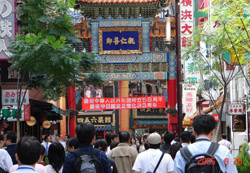 第二站參觀橫濱中華街,除於當地享用午餐外,也從經濟角度及文化融合方向來探討都市發展行為。這裡匯集了堪稱世界最大規模500餘家以上的飲食店和雜貨店,街區以紅黃色裝飾為主調,構成了橫濱市內的異國情調。中華街區內供奉三國時代英雄人物關羽為「商賈之神」,這座廟宇雕樑畫棟、輝煌壯麗,是中華街的象徵。以紅色和金色為基調的善鄰門,金碧輝煌、絢麗多彩,在中華街眾多的牌樓中最為搶眼出眾。善鄰之意是表達與近鄰、鄰國和睦相處。中華街的牌樓根據風水設計(東為青龍神、南為朱雀神、西為白虎神、北為玄武神),北為玄武門、西為延平門、南為朱雀門、東為朝陽門(臨時設立),各自鎮守四方。 第二站參觀橫濱中華街,除於當地享用午餐外,也從經濟角度及文化融合方向來探討都市發展行為。這裡匯集了堪稱世界最大規模500餘家以上的飲食店和雜貨店,街區以紅黃色裝飾為主調,構成了橫濱市內的異國情調。中華街區內供奉三國時代英雄人物關羽為「商賈之神」,這座廟宇雕樑畫棟、輝煌壯麗,是中華街的象徵。以紅色和金色為基調的善鄰門,金碧輝煌、絢麗多彩,在中華街眾多的牌樓中最為搶眼出眾。善鄰之意是表達與近鄰、鄰國和睦相處。中華街的牌樓根據風水設計(東為青龍神、南為朱雀神、西為白虎神、北為玄武神),北為玄武門、西為延平門、南為朱雀門、東為朝陽門(臨時設立),各自鎮守四方。
The Yokohama Chinatown was the second stop of the tour. Besides having lunch there, we also investigated the urban development behavior there in terms of economics and cultural fusion. In fact, it is known as the biggest Chinatown in the world with over 500 Chinese restaurants and grocery stores. The street is basically in red and yellow, forming an exotic mood in the city of Yokohama. People in the Chinatown worship General Guan Yu, a hero of the Period of Three Kingdoms, as the god of merchant. As the landmark of the Chinatown, the temple where General Guan Yu is worshipped has magnificent beams and painted columns, brilliant and splendid. The red-and-golden-colored Shanlin Arch is resplendent and magnificent, bright and colorful. It is the most eye-catching archways in Yokohama Chinatown. The meaning of shanlin in Chinese refers to being friendly and kind to your neighbors. Archways in the Chinatown were designed according to geomancy (fensui) green Dragon God in the east, Rosefinch God in the south, White Tiger God in the west, and Shuanwu God in the north. The four archways surrounding the Chinatown are the Shuanwu Arch in the north, Yenping Arch in the west, Chuche Arch in the south, and Jaoyan Arch (temporary) in the east, guarding the city from all around.
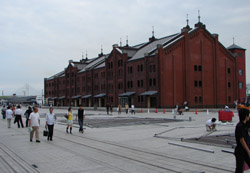 離開橫濱中華街後,考察團驅車參訪舊建築局部更新後再利用的成功案例:紅磚屋倉庫(Yokohama Red Brick Warehouse),紅磚屋倉庫為明治、大正時代的磚造建築,沿襲其受人青睞的外觀不變,內部景觀卻煥然一新。紅磚屋倉庫共有兩棟,編號分別為1號館及2號館,1號館有大廳、多功能場地,做為藝文表演、畫廊、藝術展示館及各種演講用,館內安排有定期藝文表演活動;2號館有音樂伴奏餐廳和啤酒餐廳,另外還有31家餐館和紀念精品商店,因適當的規劃及裝修,平時及假日旅客及參觀人潮不斷,另周圍是大片廣場及鄰近綠樹成蔭的公園,則是休閒的好去處,故有相當不錯的商業交易活動。離開紅磚屋倉庫後考察團來到最後一站,鄰近的橫濱山下公園,在公園內可以遠眺橫濱海灣大橋和橫濱港口內穿梭來往的船隻,保養維護良好的草坪、配置良好的植栽及適當的街道傢俱充滿了浪漫溫馨的氛圍。公園內有穿紅鞋子的少女塑像、印度水塔及美國聖地牙哥市贈送的護水神像等,印證橫濱和世界各國廣泛交流及為深度文化交融之港灣都市。 離開橫濱中華街後,考察團驅車參訪舊建築局部更新後再利用的成功案例:紅磚屋倉庫(Yokohama Red Brick Warehouse),紅磚屋倉庫為明治、大正時代的磚造建築,沿襲其受人青睞的外觀不變,內部景觀卻煥然一新。紅磚屋倉庫共有兩棟,編號分別為1號館及2號館,1號館有大廳、多功能場地,做為藝文表演、畫廊、藝術展示館及各種演講用,館內安排有定期藝文表演活動;2號館有音樂伴奏餐廳和啤酒餐廳,另外還有31家餐館和紀念精品商店,因適當的規劃及裝修,平時及假日旅客及參觀人潮不斷,另周圍是大片廣場及鄰近綠樹成蔭的公園,則是休閒的好去處,故有相當不錯的商業交易活動。離開紅磚屋倉庫後考察團來到最後一站,鄰近的橫濱山下公園,在公園內可以遠眺橫濱海灣大橋和橫濱港口內穿梭來往的船隻,保養維護良好的草坪、配置良好的植栽及適當的街道傢俱充滿了浪漫溫馨的氛圍。公園內有穿紅鞋子的少女塑像、印度水塔及美國聖地牙哥市贈送的護水神像等,印證橫濱和世界各國廣泛交流及為深度文化交融之港灣都市。
Leaving the Chinatown of Yokohama, the delegation continued the trip to the Yokohama Red Brick Warehouse, a successful case of the reuse of part of an abandoned building. The warehouse was a brick structure built during the Meiji and Taisho periods. The reconstruction didn't change anything on the warehouse appearance, though the interior was completely new. There are two buildings, Warehouse I and Warehouse II. Inside Warehouse I, there are hall and multifunctional venues for speeches and art exhibitions. In fact, the Warehouse itself holds various cultural activities regularly. Inside Warehouse II, there are a live-band restaurant, a beer restaurant, and 31 restaurants and souvenir shops. Due to the proper planning and decoration, there are countless visitors on both weekdays and holidays. The huge plaza and green parks around warehouses are ideal places for leisure. Therefore, business activities are quite vigorous there. The Yamashita Park was the last stop of our Yokohama one-day tour. Located near the Yokohama Red Brick Warehouse, people can have a good vista of the Yokohama Bay Bridge and vessels coming in and out the port from the park. With the well-maintained lawn, well-laid plantation and proper rampant furniture, the atmosphere of the park was warm and tender. Other monuments in the park included the statue of the girl in red shoes, the Indian water tank, and the water god statue presented by San Diego, USA. These have witnessed that Yokohama is a bay city with frequent exchange and cultural fusions with foreign countries.
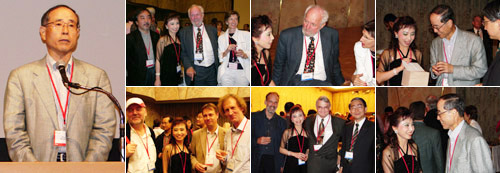
傍晚時分,所有團員回到新高輪王子飯店齊聚一堂,由黃晉英秘書長率隊參加SB05Tokyo大會所主辦的歡迎晚宴(Welcome Party),以更積極的行動拓展祐生於國際間發展的空間。在大會主席村上周三教授致歡迎詞及全體來賓舉杯互祝後揭開晚會的序幕,只見行動積極的黃晉英秘書長翩翩身影穿梭在會場中,努力搭建祐生未來可能的國際網絡,並致上祐生精心準備的紀念品予大會主席村上周三教授,無時無刻不在為國際化努力,專注負責的執行力真是令人折服。其間,更巧遇許多與祐生結緣的老朋友,例如:Raymond Cole教授、Kazuo Iwamura夫婦教授等,即使好久不見,但異地相遇還是讓人相當興奮,Kazuo Iwamura夫人更熱心地為黃晉英秘書長介紹隔日大會第一全會的專題演講人Ernst Ulrich von Weizsacker博士,交流彼此的觀點與看法,他也表達對祐生共生化理念濃厚的興趣。而其餘考察團員也使出渾身解數,鎖定來自環熱帶圈國家的與會人士交換名片,並邀約聆聽祐生於9月28日Unit 8的專題演講。歡迎晚宴結束後,空腹的黃晉英秘書長、李君如小姐、李彥頤先生以及陳秋玉小姐仍不得閒,繼續轉換陣地趕製隔日Special Session的簡報內容,在大家集思廣益地努力下,總算趕在餐廳關門前的最後一刻完成。
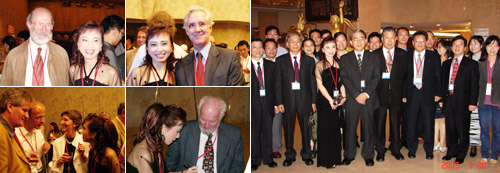
In the evening, all delegates gathered at the New Takanawa Prince Hotel to join the SB05Tokyo Welcome Party under the leadership of Secretary General Huang Chin-ying in order to expand the space of international development for the foundation. The welcome party started after the welcome address of Professor Shuzo Murakami, Chairperson of SB05Tokyo, and the toast. At the party, we saw Secretary General Huang Chin-ying shuffled aggressively across to establish the potential, future connections of the foundation and presented the delicate souvenir to Professor Shuzo Murakami, in order to do her best in the internationalization of Archilife Research Foundation. In fact, the attitude and devotion was admiring. Secretary General Huang Chin-ying also met many old friends of the foundation at the party, such as Professor Raymond Cole, Mr. and Mrs. Kazuo Iwamura etc. Though they haven't met one another for a long time, it was extremely exciting to see one another in a foreign land. Mrs. Kazuo Iwamura even introduced Secretary General Huang Chin-ying to Dr. Ernst Ulrich von Weizsacker, speaker of the keynote speech at the First Plenary Session in the day after. After Secretary General Huang Chin-ying explained the view of Archilife Research Foundation to Dr. Ernst Ulrich von Weizsacker, he expressed his special interest in our symbiosis concept. Other members of the delegations also did their best to exchange business cards with people from circum tropical countries and regions and invited them to join our keynote speech, Unit 8, on September 28. After the welcome party, Secretary General Huang Chin-ying, Miss Li Chun-ju, Mr. Li Yen-yi and Miss Chen Chiu-yu still had no time to fill up their empty stomach because they needed to finish the presentation materials for the Special Session in the following morning. With the concerted efforts of all folks, the report was finally completed when the restaurant was about to close.
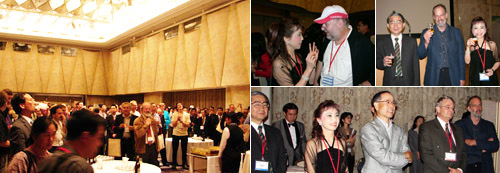
|
|